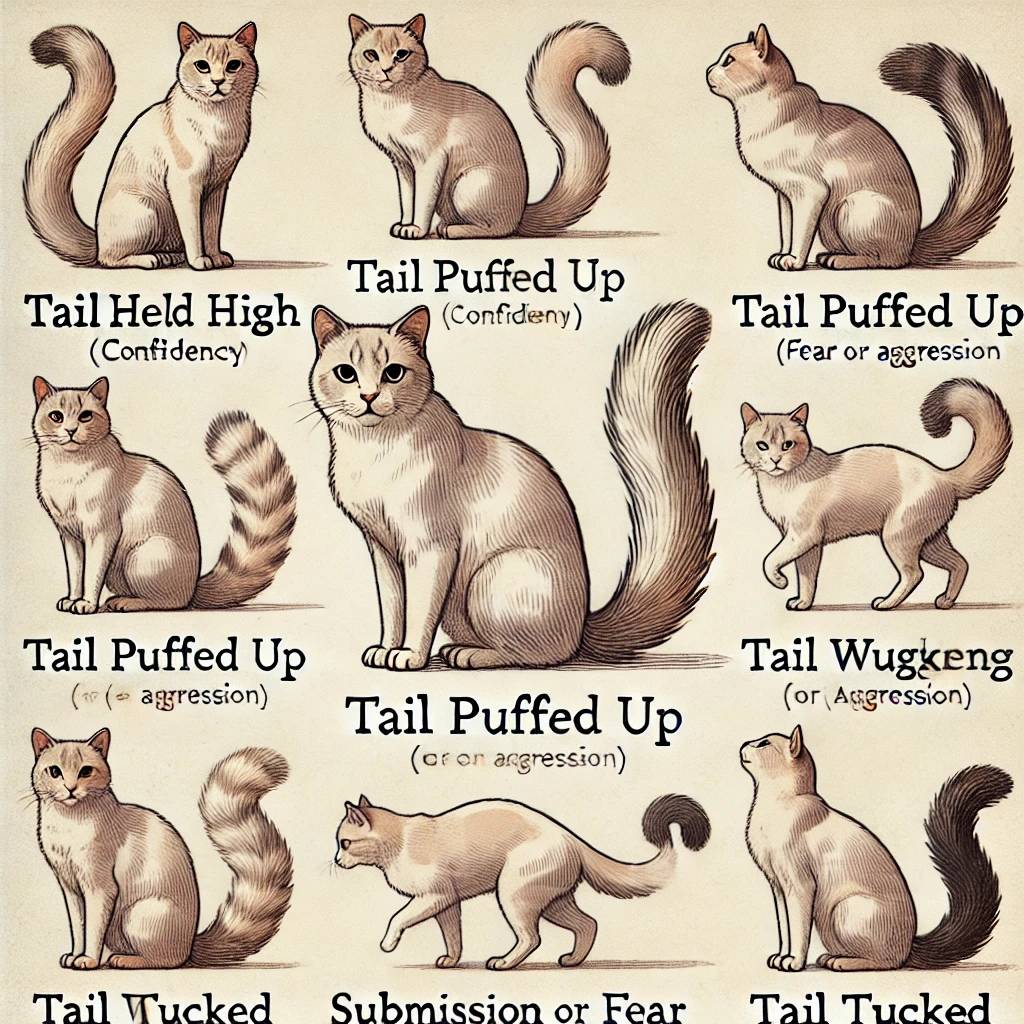Unlock the secrets of your cat’s emotions by learning to read their cat tail language.
Introduction
Have you ever wondered what your cat is trying to tell you with the flick of their tail? Cat tail language is a fascinating and essential aspect of feline communication. By understanding your cat’s tail movements, you can gain valuable insights into their emotions and needs. In this article, we’ll explore the meanings behind different tail positions and movements, and how to combine these signals with other body language cues to better understand your feline friend.
The Importance of Cat Tail Language in Feline Communication
Your cat’s tail is more than just a fluffy appendage; it’s a powerful communication tool. Cat tail language helps convey a wide range of emotions, from happiness and curiosity to fear and aggression. By paying attention to tail movements, you can respond appropriately to your cat’s feelings, strengthening your bond and ensuring their well-being.
Meanings Behind Different Tail Positions
Understanding the various tail positions is key to interpreting cat tail language. Here are some common tail positions and what they signify.
Upright Tail
An upright tail is often a sign of a happy and confident cat.
- Friendly Greeting: When your cat approaches you with their tail held high, they’re expressing happiness and a willingness to interact.
- Curiosity: An upright tail can also indicate that your cat is curious about their environment.
Question Mark Tail
When the tail is upright with a slight curve at the tip, resembling a question mark.
- Playfulness: This tail position suggests that your cat is feeling playful and may invite you to engage in some fun activities.
- Affection: It’s also a sign of affection and contentment.
Tucked Tail
A tail that’s tucked between the legs or held low indicates unease.
- Fear or Anxiety: Your cat may be feeling scared or anxious about something in their environment.
- Submission: It can also be a submissive gesture towards another animal or person.
Puffed Tail
A tail that’s fluffed up to appear larger than normal.
- Fear or Aggression: This is a defensive posture, indicating that your cat feels threatened and is trying to appear bigger to ward off danger.
- Startled Response: A sudden loud noise or unexpected event can cause your cat to puff their tail.
Swishing Tail
A tail that is moving back and forth in a swishing motion.
- Irritation or Agitation: Your cat may be annoyed or overstimulated.
- Focused Attention: If directed towards prey or a toy, it can indicate intense focus.
Twitching Tip
A gentle twitching of the tail’s tip.
- Curiosity: Your cat is interested and alert.
- Mild Irritation: Depending on context, it can also mean slight annoyance.
Wrapped Tail
When your cat wraps their tail around themselves or another creature.
- Contentment: This often signifies that your cat is comfortable and relaxed.
- Affection: Wrapping their tail around you or another cat can be a sign of bonding.
How Tail Movements Indicate Emotions
Interpreting cat tail language involves understanding the emotions behind each movement.
Confidence and Happiness
- Upright Tail: Indicates confidence and approachability.
- Question Mark Tail: Suggests happiness and a desire to interact.
Fear and Anxiety
- Tucked Tail: Signals fear, anxiety, or submission.
- Puffed Tail: Shows that your cat feels threatened.
Aggression and Irritation
- Puffed Tail with Arched Back: A classic sign of defensive aggression.
- Swishing Tail: Indicates irritation or the potential for aggression.
Curiosity and Focus
- Twitching Tail Tip: Shows interest in something specific.
- Low, Slow Wagging: Indicates stalking behavior, often seen during play or hunting.
Combining Tail Signals with Other Body Language Cues
While cat tail language provides valuable information, combining tail signals with other body language cues offers a more complete understanding of your cat’s emotions.
Ear Positions
- Forward Ears: Your cat is alert and interested.
- Flattened Ears: Indicates fear or aggression.
Eye Expressions
- Dilated Pupils: Can signify excitement, fear, or aggression.
- Slow Blinking: A sign of trust and affection.
Body Posture
- Relaxed Posture: Indicates contentment.
- Crouched Stance: May signify fear or readiness to pounce.
- Arched Back: Combined with a puffed tail, shows defensive aggression.
Vocalizations
- Purring: Usually indicates happiness but can also be a self-soothing behavior when stressed.
- Hissing or Growling: Clear signs of fear or aggression.
For more on feline body language, check out our comprehensive guide.
Responding Appropriately to Tail Signals
By interpreting your cat’s tail language and associated body cues, you can better meet their emotional needs.
Providing Comfort
- If Tail is Tucked: Offer a safe space and gentle reassurance.
- If Tail is Puffed: Give them space and avoid sudden movements.
Engaging in Play
- If Tail is in Question Mark Position: Initiate play with their favorite toy.
- If Tail Tip is Twitching: Use interactive toys to engage their hunting instincts.
Explore some fun play ideas to keep your cat engaged.
Avoiding Overstimulation
- If Tail is Swishing: Stop petting or interacting if they show signs of irritation.
- Watch for Signs of Aggression: Respect their need for space to prevent bites or scratches.
Conclusion
Understanding cat tail language is a valuable tool in building a stronger relationship with your feline companion. By paying attention to their tail movements and combining these signals with other body language cues, you can respond appropriately to their emotions and needs. This not only helps in preventing misunderstandings but also enhances the bond you share with your cat. So next time your cat flicks their tail, you’ll know exactly what they’re trying to tell you!






